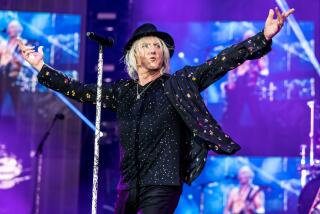‘Hot Rats’ at 50: How Frank Zappa busted up his band, moved to L.A. and helped invent jazz-rock
- Share via
America in 1969 was nearly as weird as it is today.
A seemingly endless war in Southeast Asia, the horrific assassinations of political progressives and creepy Richard Nixon’s presidency cast shadows even the last flickering flames of summer love couldn’t dispel. (Charles Manson didn’t help.)
Elsewhere in this strange world, rock still mattered a great deal to a great many people. The Band, the Byrds and their brethren were espousing an acoustic rural retreat from all that; the Grateful Dead and Jefferson Airplane were keeping the West Coast weird, although that wouldn’t last long; and King Crimson was unleashing a prog-rock masterpiece, “In the Court of the Crimson King.”
In Los Angeles, meanwhile, Frank Zappa seemed to split the difference between art, revolution and retreat when he recorded “Hot Rats,” his second yet most important solo album, during the summer of ’69. The 50th anniversary of “Hot Rats,” released in October of that year, has been observed with “The Hot Rats Sessions,” an illuminating six-CD box set co-produced by Frank’s younger son, Ahmet, and longtime Zappa “vaultmeister” Joe Travers. It’s a revealing look into the mind of a genius at the height of his powers and itching to move on.
“The Hot Rats Sessions” is the latest in a series of ambitious vault-spelunking projects undertaken by Frank’s descendants in collaboration with UMe, their long-term licensing partner since 2015. “We’re completists,” Ahmet says. “It’s like archaeology and we take it very seriously.”
Long before novelty hits like “Valley Girl” and his televised jousting with the would-be music censors of Tipper Gore and the Parents Resource Music Center, Zappa was already a musical force to be reckoned with. “Freak Out!,” his 1966 doo-wop-meets-dada-rock debut with the Mothers of Invention, was cited by Paul McCartney as inspiration for “Sgt. Pepper’s Lonely Hearts Club Band.” Zappa repaid the compliment in 1968 with “We’re Only In It for the Money,” which pilloried “Sgt. Pepper’s” with its cover and all things Summer of Love with its music.
“Hot Rats,” however, was completely different. Raw yet refined, accessible yet sophisticated, “Hot Rats” introduced what would come to be known as jazz-rock fusion, but with the added allure of Zappa’s intriguingly idiosyncratic take on classical music. Its beautifully layered textures were the result of previous experiments with variable-speed recording. For all its organic innovation, though, it was both a critical and commercial failure, topping out at No. 173 on the Billboard album chart. It did well in Europe, however, and eventually became one of the Zappa catalog’s most consistent sellers.
Zappa didn’t pal around with other rockers, preferring to hunker down in the studio and tour regularly, if not always profitably, with the Mothers. Zappa had been living in New York for two years prior to “Hot Rats,” performing surreal and improvisational shows in Greenwich Village. He was looking for a new direction when he returned to Los Angeles, where he would spend the rest of his life, in 1968. The Mothers’ failure to achieve commercial sense, and his own desire to move forward musically led Zappa to replace the Mothers with studio musicians on “Hot Rats,” with the exception of keyboards, reeds and woodwinds player Ian Underwood.
The rationale for “Hot Rats’” reliance on hired hands — and the stark reasons why Zappa disbanded the Mothers — can be gathered from an unpublished press release that would have announced the Mothers’ dissolution: “I wanted the group to be a frightening big band,” Zappa writes. “The only thing frightening about the band today is the expenses, the wrong notes & disinterested performances, and the inability of the audience to grasp what the group is really doing.” Acrimony and lawsuits inevitably followed the breakup, and Frank would assemble different and more musically pliable “Mothers” lineups in years to come.
Zappa released 62 records before his death from prostate cancer in 1993 at age 52 — and nearly as many have been released posthumously. He was driven by an extraordinary work ethic from beginning to end. In 1969 alone, “Hot Rats” was preceded in April by the densely-collaged double album “Uncle Meat.” He also produced Captain Beefheart and His Magic Band’s underground double-album masterpiece, “Trout Mask Replica”; “Permanent Damage,” by all-girl groupie group the GTOs (Girls Together Outrageously); and “An Evening With Wild Man Fischer,” a movingly destabilized double-album commentary on ‘60s rock culture. Music from the “Hot Rats” sessions would also appear on subsequent Zappa releases.
“Hot Rats” looms large for the Zappa family. “For the majority of my life I only heard Frank’s music,” says Ahmet. “Maybe 10 times at the max did I hear him play something else, like Howling Wolf or the Bulgarian women’s choir.” As for the music on “Hot Rats”: “These were my lullabies.” Older brother Dweezil, meanwhile, to whom the album is dedicated, has been performing “Rats” on the road in its entirety.
“The Simpsons” creator Matt Groening, a Zappa family friend and longtime Zappa fan, wrote appreciative liner notes prior to hearing “The Hot Rats Sessions.” After doing so, he says, “I was struck by how fun and confident the early versions of the instrumentals are, and by what a melodic genius Zappa is as both a serious composer and a rock guitar improviser.”
For Joe Travers, the eventual success of “Hot Rats” was due to “the combination of styles of music, the relatively instrumental nature of the music, and the guitar soloing. As Gail [Zappa, Frank’s late widow] told me so many times, that was the album that put Frank on the map as a guitar player.” Zappa indeed plays at his air-sculpting, storytelling best on a roughly modified Gibson Les Paul Goldtop. He also had access to more tracks on a tape recorder than ever before. Recorded on a prototype machine, “Hot Rats” became rock’s first 16-track album.
Over the course of three lengthy recording sessions, Zappa and Underwood mixed it up with adventuresome jazz-steeped studio cats including Max Bennett (bass), Ralph Humphrey (drums) and John Guerin (drums); sinuous R&B violinist Don “Sugarcane” Harris and French jazz violinist Jean-Luc Ponty; and even a 15-year-old Shuggie Otis on bass. Evocatively swinging electric chamber music rubs against vigorously dirty R&B improvisations, and a new feeling of precision prevails.
Also in the studio for the “Hot Rats” sessions was 19-year-old Bill Gubbins, whose intimate photographs and account of the experience are collected in “The Hot Rats Book” (Backbeat). Gubbins chanced upon Zappa buying a pre-gig coffee in Cleveland and requested an interview. Their meeting led to an invitation to visit the rock star in Los Angeles, where the college sophomore slept on the carpet in the Zappa family’s purple-painted living room when not enjoying a fly’s-eye view of “Hot Rats’” creation. His images reflect the calm, almost radically polite professionalism you can hear in Zappa’s musical direction during the sessions.
“Everything was very workmanlike, as you can tell from the outtakes,” says 80-year-old Ian Underwood from Portland, Ore., where he has lived since the mid-’80s. “Not that people aren’t having fun, or enjoying it, or playing the best they can, which I’m sure everybody did.” After leaving the Mothers in 1973, Underwood became a session musician himself, playing keyboards and programming synthesizers for Hollywood film scores.
For Underwood, working on “Hot Rats” was just another day at the office; the same as previous recording sessions with Zappa (whom he has described as a combination of Stockhausen, Ornette Coleman and Stravinsky), only this time without the Mothers. “It was just more music from Frank,” he says.
Not unlike Miles Davis’ “Bitches Brew” — a slice of East Coast jazz-rock yin recorded almost concurrently with Zappa’s West Coast yang — most of “Hot Rats” consists of lengthy improvisations edited down to their dramatic essences. Free jazz informs much of the album as well as its title, which was inspired by an Archie Shepp solo during “Shadow of Your Smile” that sounded to Frank like “an army of pre-heated rats screaming out of his saxophone.”
Neither rock, jazz nor fusion, “Hot Rats” is also all those things at once — and a little more besides. The thoughtful intimacy of Blue Note recordings informs “It Must Be a Camel,” while Underwood’s “Gumbo Variations” solo owes a debt to free-jazz pioneer Albert Ayler. Conversely, you can hear the influence of Zappa’s “Hot Rats” playing in Allan Holdsworth’s and Al Di Meola’s later music, while Return to Forever, Weather Report and others would pick up on his newly expanded sonic palette. And, having performed with Zappa, violinist Jean-Luc Ponty would always retain a Zappa tinge. But while Miles Davis would continue to record music in the vein of “Bitches Brew,” “Hot Rats” was a one-off whose ongoing influence was more about ambition than imitation.
Perhaps most significantly, “The Hot Rats Sessions” is a monument to Zappa’s process. On disc one, you can hear “Hot Rats” opening track “Peaches En Regalia” expand from basic rhythm tracks into a finished product containing 10 layers of Underwood horn overdubs. To begin another disc, Travers edits the sound of Zappa lighting a cigarette, and then coughing, to a needle dropping onto an acetate containing an early-’60s version of “Little Umbrellas.” Travers wanted listeners to feel as though they were in the room with Zappa. “It’s almost as if he’s sitting and presenting this material to you,” he says.
The meat of “Hot Rats,” though, lies in long, consistently energized improvisations. Expansive master takes of “Willie the Pimp,” “The Gumbo Variations” and “Son of Mr. Green Genes” appear on “The Hot Rats Sessions” in their uncut, multi-take, bonus-guitar-solos glory.
“On the guitar-solo options, Frank is tearing it!” says Ahmet. “It’s like you’ve been given the Lego pieces to build your own ‘Hot Rats’.”
After “Hot Rats,” Zappa released a pair of albums recorded by the Mothers of Invention — “Burnt Weeny Sandwich,” released only four months later, represents the original Mothers at their strangest, funniest and most musically profound — and then another solo album, “Chunga’s Revenge.” And that was only 1970. Frank Zappa continued to perform and record prolifically until his death, leaving a vault’s worth of released and unreleased material to savor through the inevitably weird times ahead.
More to Read
The biggest entertainment stories
Get our big stories about Hollywood, film, television, music, arts, culture and more right in your inbox as soon as they publish.
You may occasionally receive promotional content from the Los Angeles Times.










